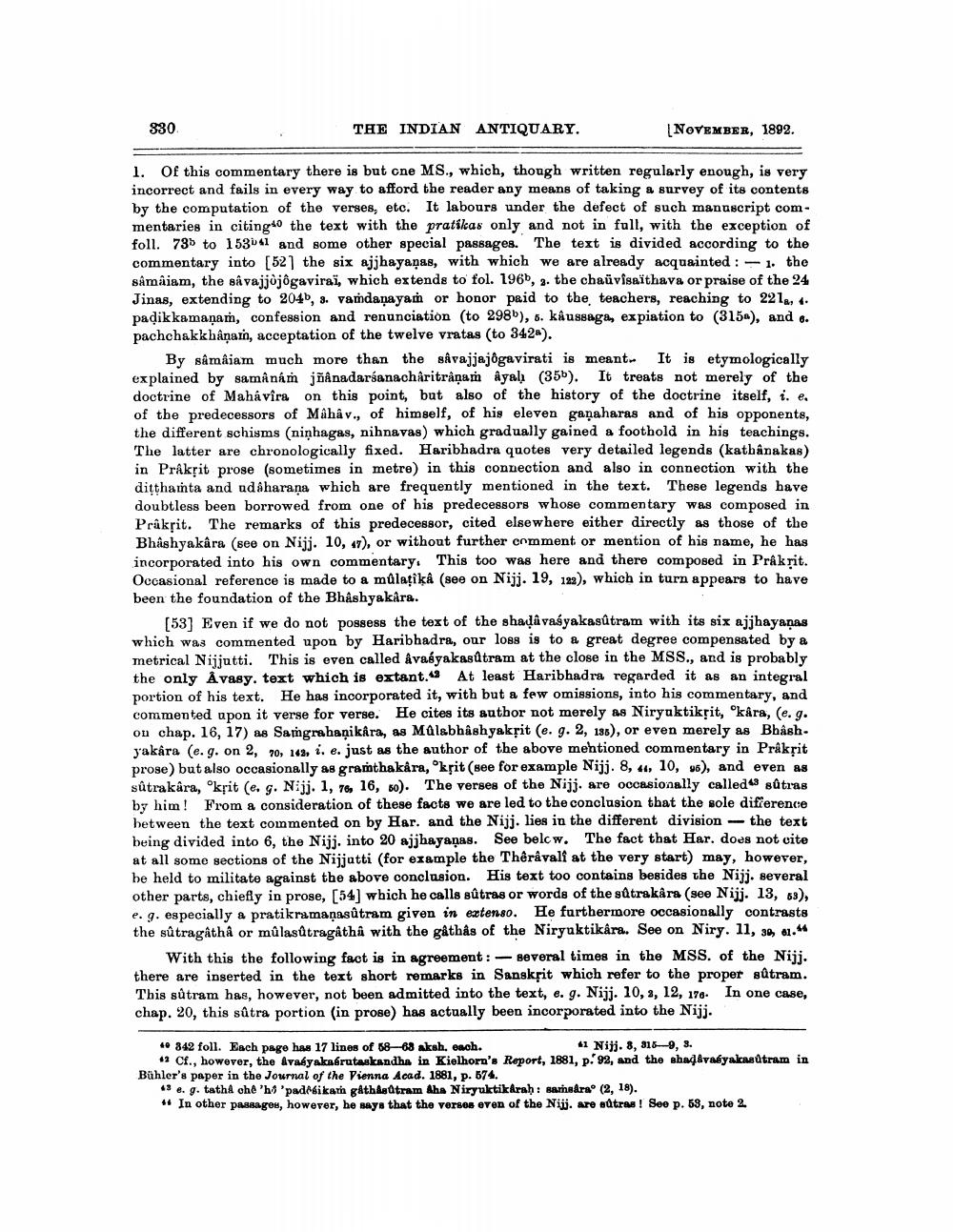________________
THE INDIAN ANTIQUARY.
1. Of this commentary there is but cne MS., which, though written regularly enough, is very incorrect and fails in every way to afford the reader any means of taking a survey of its contents by the computation of the verses, etc. It labours under the defect of such manuscript commentaries in citing the text with the pratikas only and not in full, with the exception of foll. 73 to 15341 and some other special passages. The text is divided according to the commentary into [52] the six ajjhayanas, with which we are already acquainted: 1. the sâmâiam, the sâvajjojôgaviraï, which extends to fol. 196b, a. the chaüvisaïthava or praise of the 24 Jinas, extending to 204b, s. vamdanayam or honor paid to the teachers, reaching to 221a, 4. paḍikkamanam, confession and renunciation (to 298b), 6. kâussaga, expiation to (315), and 6. pachchakkhânamn, acceptation of the twelve vratas (to 342a).
330
[NOVEMBER, 1892.
By sâmâiam much more than the sâvajjajogavirati is meant It is etymologically explained by samânâm jñânadarsanacharitraṇam ayal (35b). It treats not merely of the doctrine of Mahavira on this point, but also of the history of the doctrine itself, i. e. of the predecessors of Mâhâv., of himself, of his eleven ganaharas and of his opponents, the different schisms (ninhagas, nihnavas) which gradually gained a foothold in his teachings. The latter are chronologically fixed. Haribhadra quotes very detailed legends (kathanakas) in Prakrit prose (sometimes in metre) in this connection and also in connection with the diṭṭhamta and udaharana which are frequently mentioned in the text. These legends have doubtless been borrowed from one of his predecessors whose commentary was composed in Prakrit. The remarks of this predecessor, cited elsewhere either directly as those of the Bhashyakâra (see on Nijj. 10, 47), or without further comment or mention of his name, he has incorporated into his own commentary. This too was here and there composed in Prakrit. Occasional reference is made to a mûlațikâ (see on Nijj. 19, 122), which in turn appears to have been the foundation of the Bhâshyakâra.
[53] Even if we do not possess the text of the shaḍâvasyakasûtram with its six ajjhayanas which was commented upon by Haribhadra, our loss is to a great degree compensated by a metrical Nijjutti. This is even called âvasyakasûtram at the close in the MSS., and is probably the only Avasy. text which is extant. At least Haribhadra regarded it as an integral portion of his text. He has incorporated it, with but a few omissions, into his commentary, and commented upon it verse for verse. He cites its author not merely as Niryaktikṛit, kâra, (e. g. on chap. 16, 17) as Samgrahanikâra, as Mûlabhâshyakṛit (e. g. 2, 138), or even merely as Bhashyakara (e. g. on 2, 70, 143, i. e. just as the author of the above mentioned commentary in Prakrit prose) but also occasionally as gramthakâra, "krit (see for example Nijj. 8, 44, 10, 6), and even as sûtrakâra, krit (e. g. Nijj. 1, 76, 16, 50). The verses of the Nijj. are occasionally called 43 sûtras by him! From a consideration of these facts we are led to the conclusion that the sole difference between the text commented on by Har. and the Nijj. lies in the different division the text being divided into 6, the Nijj. into 20 ajjhayanas. See below. The fact that Har. does not cite at all some sections of the Nijjutti (for example the Thêrâvalî at the very start) may, however, be held to militate against the above conclusion. His text too contains besides the Nijj. several other parts, chiefly in prose, [54] which he calls sûtras or words of the sûtrakara (see Nijj. 13, 63), e. g. especially a pratikramaṇasûtram given in extenso. He furthermore occasionally contrasts the sûtragâthâ or mûlasûtragatha with the gåthås of the Niryuktikâra. See on Niry. 11, 30, 81.44
---
With this the following fact is in agreement: several times in the MSS. of the Nijj. there are inserted in the text short remarks in Sanskrit which refer to the proper sûtram. This sûtram has, however, not been admitted into the text, e. g. Nijj. 10, 2, 12, 176. In one case, chap. 20, this sûtra portion (in prose) has actually been incorporated into the Nijj.
40 342 foll. Each page has 17 lines of 58-68 aksh. each.
41 Nijj. 8, 315-9, 3.
42 Cf., however, the Avagyakaérutaskandha in Kielhorn's Report, 1881, p. 92, and the shadivasyakasútram in Bühler's paper in the Journal of the Vienna Acad. 1881, p. 574.
43 e. g. tathả chê hộ ’paddśikam g&thâs@tram cha Niryuktikdrah: samudra (2, 18).
* In other passages, however, he says that the verses even of the Nijj. are sûtras! See p. 58, note 2.




